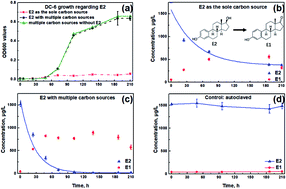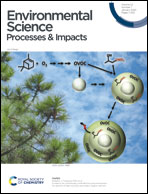Effects of carbon sources on 17 beta-estradiol degradation by Sphingomonas sp. and the analysis of the involved intracellular metabolomics†
Abstract
17β-estradiol (E2) ubiquitously exists in various water bodies with long-term endocrine-disrupting and carcinogenic impacts on wildlife even at the trace level of ng L−1. However, it remains unclear how easy-to-degrade carbon sources alter E2 biodegradation patterns. In this study, E2 biodegradation by Sphingomonas sp. MCCC 1A06484 was investigated with regard to alternative carbon sources. Results showed that the bacterium preferentially utilized glucose, sodium succinate and sodium acetate over E2. Interestingly, the presence of these preferred nutrients increased the E2 removal efficiency by 20.1%. Furthermore, a positive relation (p < 0.05) between the utilization of total organic carbon (TOC) and E2 was found. Using intracellular metabolomics by UHPLC-QTOF-MS, 11 up-regulated and 35 down-regulated metabolites (variable importance > 1, p < 0.05) were identified in the bacterium when cultivated with E2 under various carbon and nitrogen backgrounds. The E2 exposure contributed to metabolism changes of lipid, nucleotide, carbohydrate, amino acid and membrane transport, which were considered to play roles in the E2 metabolism. The up-regulated phosphatidylcholine might act as an indicator during the bacterial degradation of E2. Generally, this study contributes to an in-depth understanding of E2 biodegradation in complex environments with multiple carbon and nitrogen sources.



 Please wait while we load your content...
Please wait while we load your content...